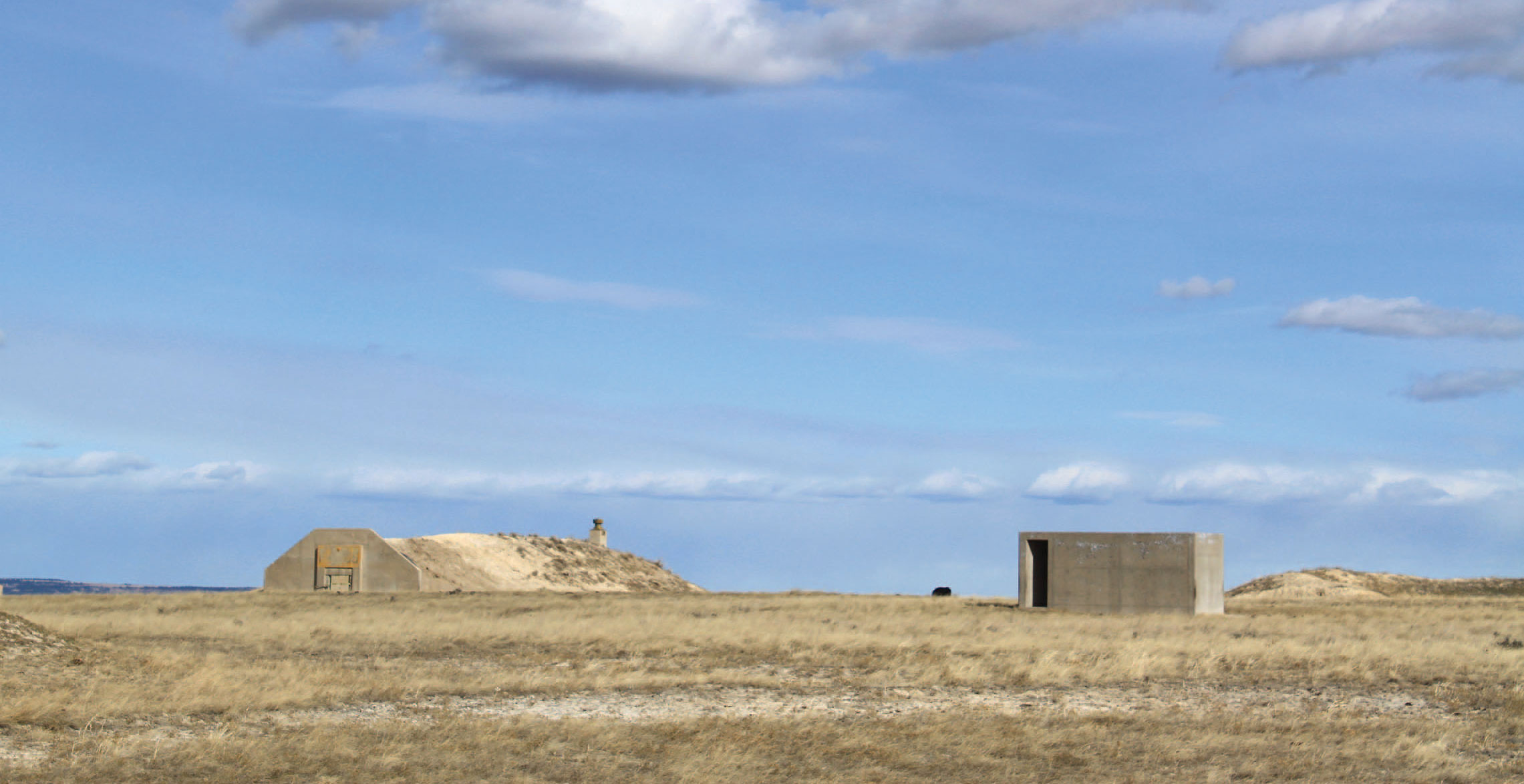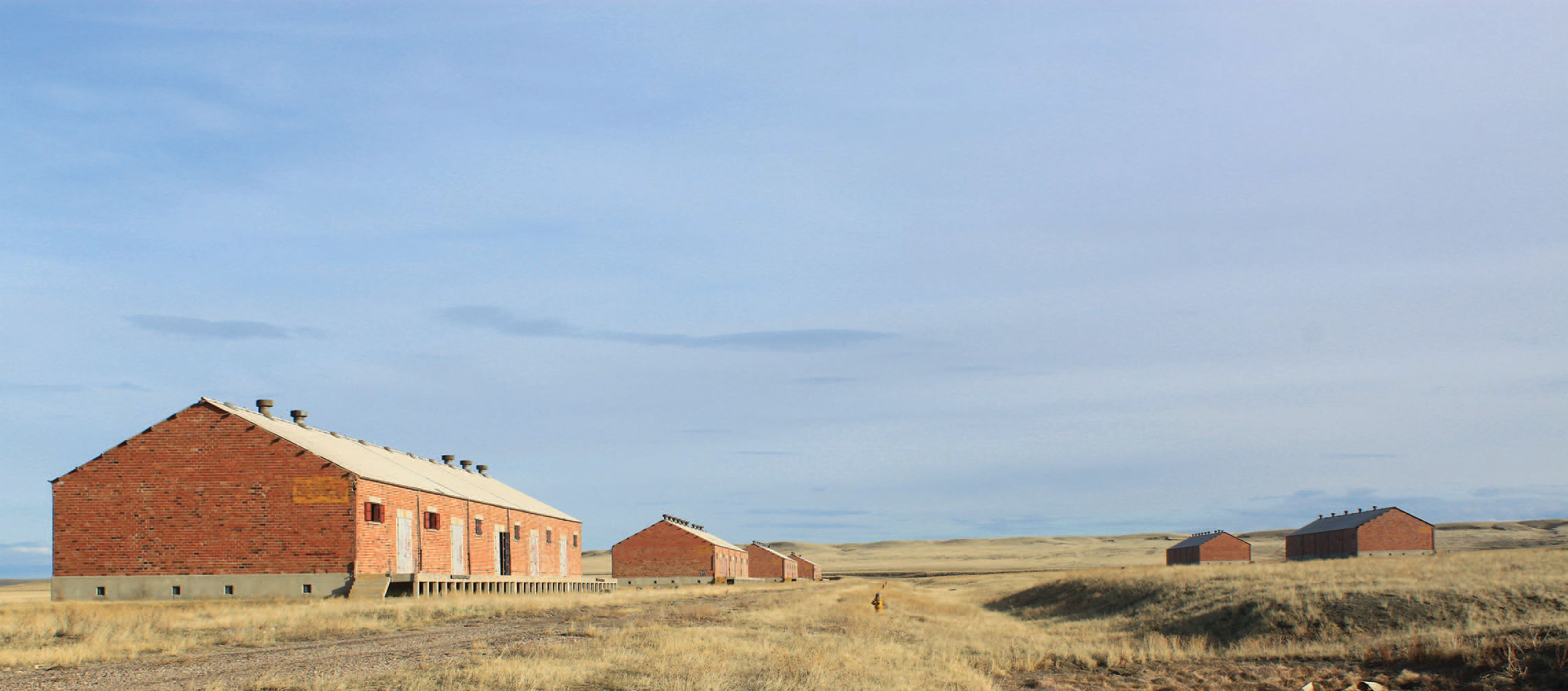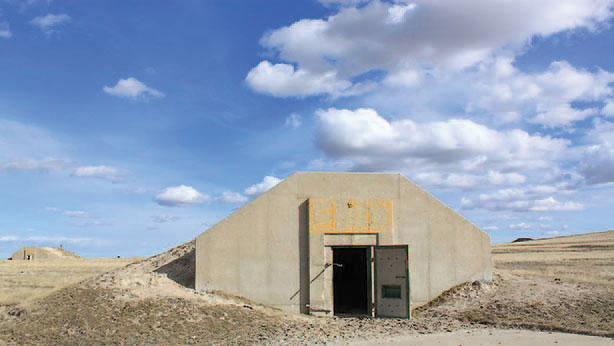
Out among the rolling hills of Fall River County lie the traces of a once-bustling wartime melting pot.
There’s a lost city out among the rolling hills of Fall River County, south of Red Canyon, where the last ponderosa stands give way to yucca-studded grasslands undulating outward like a rattlesnake glissade. For some — children of the Great Depression and World War II, real-life Rosie the Riveters, Lakota People looking for a better life off the reservations — the strange ruins faintly visible from State Highway 471 were once their own little prairie heaven.
Watch carefully from the road and you might not know what to make of what you see — when suddenly hundreds of earth-covered domes bulge from a sun-facing slope, all in tidy rows, concrete faces casting shadows.
This was Igloo, South Dakota. For 24 years, the U.S. Army’s Black Hills Ordnance Depot provided livelihoods for thousands of workers and their families here — as well as a sense of community and solidarity of purpose unlike anything that many Igloo alums feel they’ve ever seen since.
In 1941, as the United States prepared for the possibility of entry into WWII, the U.S. Army Ordnance Department sought to vastly increase its weapons and ammunition storage facilities. Western South Dakota and Nebraska were viewed favorably for munitions storage, as their altitudes and low humidity were conducive to longer shelf life. Congressional Rep. Francis Case lobbied hard for the Southern Hills. And though there were concerns about where the help would come from in such a sparsely populated area, the presence of the Chicago, Burlington, and Quincy Railroad helped win the day for the future BHOD.
A 21,000-acre site was acquired in the treeless, coyote-wandered hills between Edgemont, South Dakota, and the small village of Provo. The devastation wrought by the Dirty Thirties had already depopulated much of the land, making acquisition a less painful process. The U.S. Army Corps of Engineers set up shop at Union Station in Hot Springs, a town hard-hit by the Depression. Construction began in the spring of 1942. By August, 6,000 workers were employed on the project, twice the population of Hot Springs.
Nearly overnight, tiny Provo was transformed into a workers tent camp. Other workers commuted from Edgemont and Hot Springs. Private homes became makeshift cafeterias. Every available living space nearby was rented. Wooden sheds were converted into sleeping quarters.
Conditions may have been squalid during construction, but the region was still reeling from the Depression. Building the BHOD was a paying job, and permanent employment at the depot would be a better gig than anybody could have known.
Robert Raymond, a kid from the Rosebud Sioux Reservation, moved to the Provo workers colony with his sister and her husband in ’42. “We lived in a tar paper shack and a tent,” he recalls. But the lean times paid off. “After a year, we were eligible to move into Igloo. It was the best place I ever lived in my life.”
Construction of the BHOD was a tremendous feat of engineering, logistics, and labor. In just a few months, 801 of the “igloo” structures that would give the installation its name were erected.
Purpose-built for munitions storage, the reinforced concrete domes — called “igloos” because they were thought to resemble traditional Inuit ice dwellings — covered with earth, were designed to direct explosions upward, not outward. Housing units and communal spaces were also built, and a looped railroad spur accessible to the igloos for loading and unloading war materials was put in place.
A movie theater was picked up and moved from Lusk, Wyoming. A grocery store was hauled over from Chadron, Nebraska. Stonemason Monte Nystrom — famous for his Black Hills stonework including the State Game Lodge at Custer State Park — built several sandstone guard posts. The first shipment of munitions started coming in the fall of the same year construction started.
These were heady times at the BHOD. “The sheer excitement, 24/7 hustle and bustle of wartime — neighbors coming home from or going to war. Test explosions on the prairie” — are some of famous resident Tom Brokaw’s memories of his years (1943 – 44) at Igloo.
The Ordnance Department was one of the largest employers of civilians during the war, and for a Fall River County hard-pressed for jobs, the BHOD was a Keynesian dynamo. Clarence Anderson moved to Igloo from Hot Springs as a young boy. “Our family was extremely poor,” he says. “We moved from a house that had two rooms and a path out to the outhouse. We had running water from one spigot. We had one light bulb that had a light socket set up to where we could have extension cords. I remember my mother had gone out and bought a toaster, and we were all so excited because, before that, our toast was always made on the wood stove. When we moved to Igloo, we were very similar to all the families coming there. They were families that were out of work looking for a place to get a new start. We moved into a house that had five rooms, two bedrooms, and an interior bathroom with running water. We were really excited as kids over that.”
“The Depression was just over,” Raymond says. “We basically had nothing back on the reservation. We moved there and we had everything — there were jobs, money, brand-new houses, indoor plumbing, iceboxes, a brand-new school.”
Despite the tough times, labor was still an issue since nearly all of the military-aged men were off fighting when Igloo came on line. The Ordnance Department had to look outside of the traditional labor pool for workers. Recruiters worked hard to attract workers from the Pine Ridge and Rosebud Sioux reservations. By 1945, 160 Native Americans were employed at BHOD.
Native American recruitment overlapped with heavy recruitment of women. When the first munitions shipment arrived at BHOD, Goldie Lovell, a pioneering female truck driver, was there to haul the cargo to storage. Women like Lovell were Women Ordnance Workers. Immortalized by campaign poster icon “Rosie the Riveter,” WOWs worked at many traditionally male occupations during the war effort. Like Rosie, they often wore a red bandanna. But instead of the white polka dots Rosie wears, theirs were emblazoned with white bombs, fuses lit.
“At Igloo, many, many of the workers were females, including my sister,” Raymond says. In that, Igloo was in line with depots and armories throughout the nation. In 1943, WOWs constituted more than 43 percent of the Ordnance Department workforce nationally.
A stanza written by Igloo worker Clara Jackman captured WOW pride in verse:
Though we’re not Miss Americas
Nor shaped like ancient Venus
We’re doing a job for Uncle Sam,
You’ve got to hand it to us.
For those who could find (even better, hold onto) a job at Igloo, the post offered adequate — if not fancy — housing and a self-contained community with a grocery store, bowling alley, roller rink, the Cactus Inn lounge, even a dance hall where acts like the Tex Beneke Orchestra would come to play.
Anything Igloo didn’t have could be found in Edgemont. Many families didn’t own a car, but that was no problem. “There was a bus that went back and forth to Edgemont,” Anderson says. “At the time that Igloo was developed, very few people had cars. And for those who did, not long after they decided people had to have insurance, so if you didn’t have liability insurance you had to park your car right inside the gate.”

Igloo attracted some notable intellectuals. Plains sage Archie Gilfillan, whose Sheep: Life on the South Dakota Range is a classic reflection on butte country sheep herding, spent seven years as an editor and writer for Igloo Magazine. Raymond went on to become an engineer and memoirist of the war years with his Scouting, Cavorting and Other World War II Memories. Dr. William A. Nolen — whose literary accounting of his apprenticeship at Bellevue Hospital in New York, The Making of a Surgeon, has been read by millions — served at the BHOD clinic as an Army doctor from 1955 – 57.
One unique aspect of Igloo life that there seems to be some consensus on — people got along regardless of their ethnic background. For a hardscrabble, working-class town built from nothing on a desolate stretch of sunbaked steppe, Igloo was a real-deal melting pot by many accounts.
“We lived in a section of Igloo where the housing was mostly Indian,” Raymond says. “However, other Indian families were scattered throughout the housing area. There was no apparent racism to me.”
“In 1943, the American Indians were very much prejudiced against, and they moved there and joined in with all the other people and became part of that big family,” Anderson says. “Many didn’t stay long because it was an awfully new culture for them, but an awful lot of them stayed for the duration and went to school with us. As young kids, we had no idea that there was a prejudice against Indians because they were our neighbors and friends.”
Charles Zimiga (Lakota), another Igloo alum, told the Native Sun News in 2012 that, “When I lived there, I was just ‘Charles Zimiga.’ In a way, it was like the outside world wasn’t like Igloo because I never felt any prejudice, and I thought the whole world was like that. It was a place where you were just who you were.”
In addition to white, Native American, and African American employees, a contingent of Italian prisoners of war occupied Igloo during the WWII era. They served as part of a national experiment with “Italian Service Units,” in which Italian POWs who didn’t demonstrate overt fascist leanings were allowed some measure of freedom in exchange for work. It’s rumored that the Italians had a knack for drawings, and that some of their bawdier masterpieces can still be seen inside some of the igloos. Another rumor is that with so many men deployed to the front, some slightly swarthier South Dakotans may have been conceived at Igloo.
The Igloo years included the baby boom, and, unsurprisingly, people who grew up there remember it as a paradise for kids. “There was lots of kids around,” remembers former resident Beverly McBride. “It was very family-oriented. The houses were small but nice. Every house had a sidewalk.”
“People were just coming off food stamps,” Yvonne Grubbe says. “We had the commissary, and that food came through the military. So we had a lot of advantages out there. You know all of the new buildings and everything, the schools. We had a roller skating rink that was fabulous. And there was a big wonderful swimming pool, a huge community center, two basketball courts. You can walk around anytime, day or night. We had a big theater, and I think the first price I ever paid to go to a movie was 15 cents. Mom would give me a quarter, and I could get a cold drink and popcorn with the rest of the change. They had all the movies that were put out in the big cities. We never had a loss for things to do.”
Facilities for play were abundant. Basketball was the most popular sport. Jim Anderson, who’s compiled an extensive online catalog of BHOD memorabilia, remembers how the students from the reservations brought their “run and gun, full-court press” style of play — popularized by Leonard Quick Bear and the St. Francis Mission teams of the 1930s — to the gyms at Igloo. The Provo Rattlers took their high-energy game to three state tournaments, making it to the 1954 finals (where they lost to Hayti) behind two Lakota stars, brothers Dan and Herb Goodman.
The federal government recognized in 1942 that the children of itinerant BHOD construction workers, and ultimately permanent employees, were going to need an on-site school. In a matter of weeks, enrollment at the Provo School had jumped from 15 to more than 200. Longtime Buffalo Gap, South Dakota, principal Adelaide Ward was brought in as district superintendent, along with her lifelong colleague and friend Christina Hajek. The two devised a temporary plan to expand the Provo School and bus excess students to school in Edgemont until a permanent school for the children of BHOD workers could be constructed at Igloo. In 1943, the new school was completed. Although situated on Igloo proper, the school was still administered by the Provo School District, hence the school retained the Provo name, and Igloo athletes wore the Provo Rattlers uniform.
Ward was a towering figure in the minds of Igloo youth, and undoubtedly made an impact on a generation of kids from Dust Bowl beginnings.
“I’ve always felt that she was one of the people that put me on track to what otherwise might not have been a very successful life,” Clarence Anderson says. “She was a pusher. When she walked down the hallways, you could hear her for a long ways. She’d been in a car accident and had a pretty healthy limp, and she was not overly heavy but a big woman, and when she’d walk you could hear her coming. I think to this day she did it purposely, because everybody kind of shaped up as she was coming down the hall.”
“I was like, Man we can’t get away from her, what’s the deal here?” Grubbe says. “She was quite a disciplinarian, and all she had to do was walk down the aisles and the hallways. And you never knew when she’d show up at the door at any classroom and just watch and be quiet. We’d behave because we didn’t want her to catch us doing anything bad. She never even had to raise her voice, really. She had the power, and we knew she did. And of course that was a different time. We didn’t sass back. We did our homework. We didn’t really do anything out of line. Anything that we did went back to our parents.”
Ward served as principal of Provo High School until her retirement in 1961. Hajek served as principal of Provo Elementary. The two moved away some time after retirement but occasionally returned to take care of business at the house they owned together in Provo, and possibly to maintain a connection to the community.
By summer of 1945, some 4,200 people lived at Igloo, more than in Hot Springs today. As Igloo grew, so did the surrounding towns. The war effort had elevated this sleepy backwater — hammered by broken banks, ruined homesteads, and the decline of Hot Springs as a well-heeled spa resort — to a thriving economy with a housing demand that was hard to keep up with.
Postwar, over a period of several years, there was a dramatic decrease to about 700 BHOD employees and a return to something more like the prewar gender balance in the workforce.
While female workers would always play a major role at Igloo, victory overseas ended the halcyon red bandanna days. “When the war ended and the veterans came back,” Raymond says, “they had veterans’ preference, and most of those females lost their jobs as veterans took over.” Raymond’s sister was one of those who lost her job, so the family moved on.
The conflict deficit didn’t last long. In the summer of 1950, North Korean troops crossed the 38th parallel and America became involved in another war in Asia. The Korean War effort nearly doubled the number of workers to about 1,300.
After Korea, there was another slowdown and some workers were laid off. Then life went on for the workers and families at Igloo. There was always the occasional rumor that the depot would lay off more people or shut down for good, but it was the height of the Cold War. Keeping America’s military good and lethal was the lifeblood of the prairie melting pot. When Nikita Khrushchev assaulted his desk with a loafer at the United Nations General Assembly, that was probably a net benefit for wage earners from Hot Springs and Pine Ridge who might land a gig at Igloo.
In the absence of a major war, the installation made itself useful as a conveniently remote place to conduct bomb disposal and explosive ordnance parts salvage. In 1962, a relative peacetime, 575 civilian and military employees worked at Igloo, and about 1,800 people lived there.

Ironically, the decision to shut down Igloo was made during the ramp-up to the Vietnam War (during which, by some estimates, up to 7 million pounds of ordnance were dropped on Vietnam, Laos, and Cambodia). In 1964, Secretary of Defense Robert McNamara supported efforts to reduce military expenditures, even as he recommended a bombing campaign against North Vietnam. The BHOD and 95 other installations quickly found themselves in the crosshairs of the Department of Defense.
“A cry of anguish went up from coast to coast,” wrote South Dakota Sen. George McGovern in an editorial for The Progressive titled “Swords into Plowshares.” The statement wasn’t entirely hyperbolic. Workers — and their representatives — at installations from the Brooklyn Navy Yard to BHOD argued that the cuts would devastate economies and communities.
McGovern was empathetic: “One readily sympathizes with the men and their families who lose their jobs as a result of defense shifts or cutbacks.” But he was also circumspect: “Do we want the Defense Department to meet the military needs of the nation in a businesslike manner, or do we want it to function as a gigantic WPA responding to local and Congressional pressures all across the land?”
From a budgetary perspective, he had a point — one that dovetailed well with a larger point he was making (one that’s still argued today), that “many of the most vocal ‘economizers’ are the biggest ‘spenders’ when it comes to armaments. Place the label ‘defense’ on a project and it will zip through the Congress with little or no floor debate.”
Still, one could argue that if any DOD project in America warranted the WPA treatment at the time, it was Igloo. The BHOD not only helped revive a severely depressed portion of the former Dust Bowl, it was also probably one of the federal government’s most successful attempts at a long-term employment program for Native Americans from Plains reservations. For that reason McGovern (despite his misgivings) and Sen. Karl Mundt did plead with the Secretary of the Army that Igloo was an extraordinary case, that nearly 20 percent of workers employed were Native American, that the closure would ripple outward damaging communities throughout the area. Edgemont had just built a new hospital, which wouldn’t likely survive.
In April, McNamara announced the impending closure of Igloo, to be carried out in phases, completed by the summer of 1967. Less than six years before Pine Ridge Reservation would erupt into open insurrection at Wounded Knee, tribal members lost not only a rare source of employment, but something rarer still — a place where Lakota and other Native Americans had worked and lived in relative harmony with whites and other non-Indians for 25 years.
After the closure, Provo dwindled down to a few houses. Edgemont prepared for the worst: “It was devastating,” says Clarence Anderson, who lives in Edgemont. “I remember the day when the announcement came out. It was just like the town had a heart attack. When the base closed, that was just a tremendous impact on the community. I would say almost half the population of Edgemont was lost at that time. We had a very vibrant business community — three auto dealerships, three hardware stores, two grocery stores, clothing stores — and it just went down to virtually nothing.”
The DOD attempted to move displaced employees to other bases. As workers moved on, the short-lived prairie Utopia was systematically dissolved by the cool bureaucratic hand. Grubbe, having grown up a child of Igloo, worked at the business of taking it apart. “As people were transferring to different installations, the Army and Air Force would see what was available on this great big sheet that went out from the government. If they needed this stuff, it would be shipped out to whoever asked for so many chairs, or so many beds, or whatever.
“And they even came in and took out the individual houses. There’s housing that came from Igloo all throughout the state. Lots of it went down to the Indian reservations. A lot of it came to Edgemont. People bought the duplexes and remodeled them. We tried to get rid of everything we possibly could.”
The 801 igloos and some other structures remain. Through the years, several schemes were hatched — including frozen meat storage — to make good economic use of the igloos, but none panned out. The prairie Utopia is now entirely situated on private ranch land — a strange, distant sight, like an apparition on a seldom-traveled road.
From the February/March 2017 issue.













